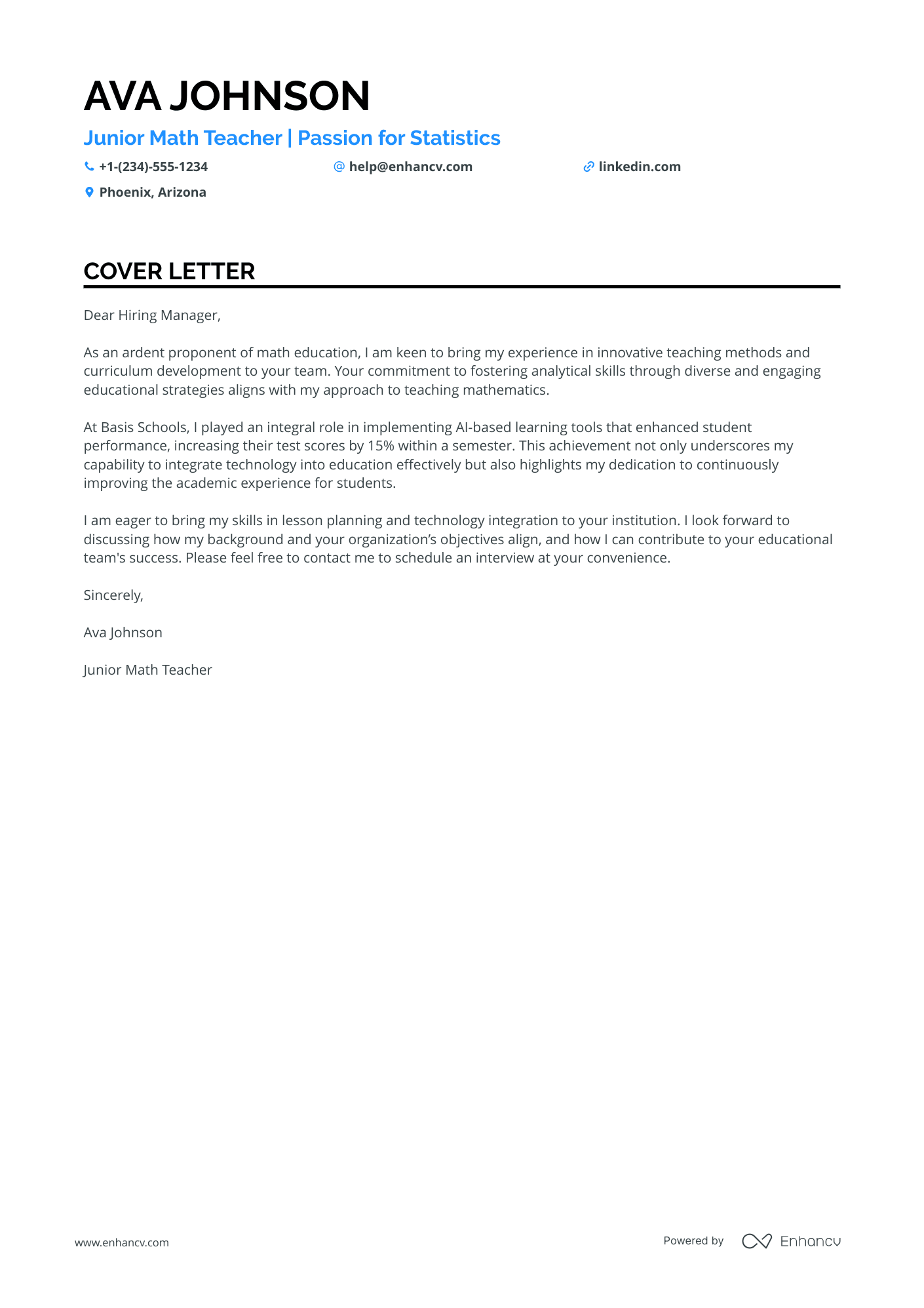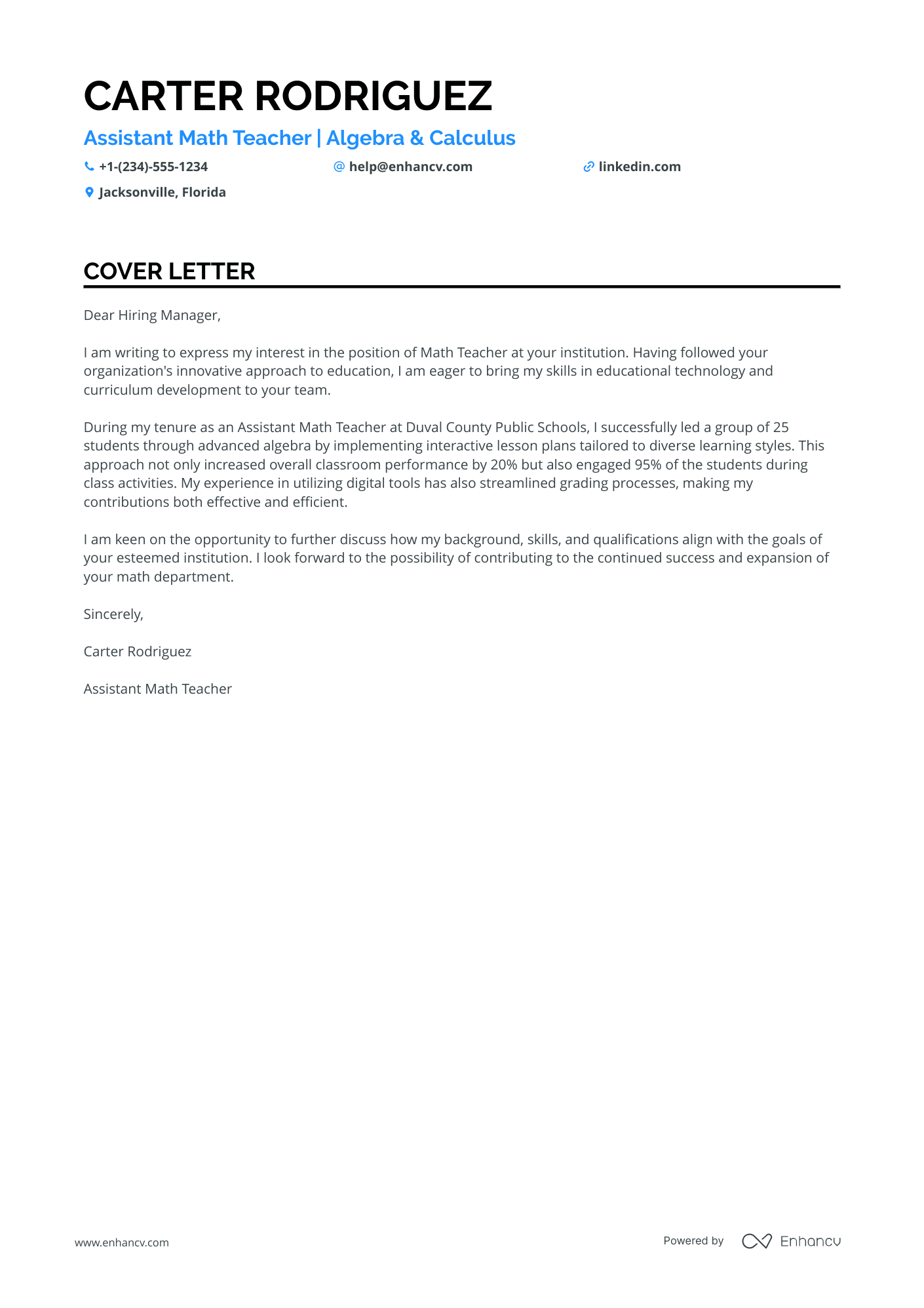You're ready to craft a math teacher cover letter, but the blank page before you poses a challenge. You've submitted applications and noticed they often require this personal touch—a narrative that doesn't echo your resume, but instead, illustrates your most significant professional triumph. Your letter must be polished, free from clichés, and concise, never exceeding one page. Let's embark on shaping your story into a compelling, one-page presentation that highlights what makes you an extraordinary educator.
- Introduce your profile to catch recruiters' attention;
- Use professional templates and examples to make sure your math teacher cover letter follows the best industry standards;
- Settle on your most story-worthy achievement to shine a light on what makes your application unique;
- Write a math teacher cover letter, even when you lack professional experience.
Ready to start with the basics: upload your resume to Enhancv's AI, below, to see the math teacher cover letter it would write for you.
If the math teacher isn't exactly the one you're looking for we have a plethora of cover letter examples for jobs like this one:
Drop your resume here or choose a file.
PDF & DOCX only. Max 2MB file size.
Math teacher cover letter example
Carter Rodriguez
Philadelphia, Pennsylvania
+1-(234)-555-1234
help@enhancv.com
- Highlighting measurable achievements (30% increase in student engagement, 25% improvement in scientific understanding) effectively illustrates the candidate's impact on educational outcomes and backs up claims with concrete data.
- Emphasizing relevant experience in the field (Lead Science Teacher, curriculum development, incorporating educational technologies) directly connects the candidate's background to the needs of the role.
- Expressing alignment with the institution's values (commitment to fostering a dynamic and effective learning environment) shows the candidate's understanding of and fit with the school's culture and mission.
- Proactive approach by inviting the hiring manager for a discussion (invites you to discuss) demonstrates the candidate's confidence and eagerness to engage in further conversation about how they can contribute to the school.
Structuring and formatting your math teacher cover letter
Here's what the structure of your math teacher cover letter should include:
- Header (with your name, the position you're applying for, and the date);
- Salutation (or greeting);
- Introductory paragraph (or your opening statement);
- Body paragraph (or further proof of your experience);
- Closing paragraph (with a call to action);
- Signature (that is optional).
Use the same font for your math teacher resume and cover letter - modern fonts like Lato and Rubik would help you stand out.
Your math teacher cover letter should be single-spaced and have a one-inch margins - this format is automatically set up in our cover letter templates and our cover letter builder.
When submitting your cover letter, always ensure it's in PDF, as this format keeps the information intact (and the quality of your document stays the same).
On one final note - the Applicant Tracker System (ATS or the software that is sometimes used to initially assess your application) won't read your math teacher cover letter.
No time for a cover letter? Use our free cover letter generator and craft one effortlessly from your resume.
The top sections on a math teacher cover letter
Header with Contact Information: Include your name, address, phone number, and email so that the school can easily reach you for an interview. This conveys professionalism and a readiness to engage in formal communication.
Introduction Mentioning Teaching Philosophy: Start with an engaging opening that includes your teaching philosophy. Explaining your approach to mathematics education immediately shows your passion and commitment to effective teaching.
Body Highlighting Relevant Experience: Use the body of the letter to detail your experience teaching math, including any specific curriculums you've taught or relevant accomplishments. This section should showcase why you're a particularly good fit for a math teaching position.
Description of Classroom Management Skills: Include a discussion about your classroom management techniques and how you facilitate a positive learning environment. This is essential in a math classroom to maintain student engagement and discipline.
Closing with a Call to Action: Conclude the letter by reiterating your enthusiasm for the position and suggesting a meeting or interview to discuss how your math expertise aligns with the school's needs. This demonstrates your proactive attitude and eagerness to contribute to the school community.
Key qualities recruiters search for in a candidate’s cover letter
- Demonstrated proficiency in mathematics: Recruiters look for a strong foundation in mathematics, showing that you have the content knowledge necessary to teach the subject effectively.
- Experience with curriculum development: The ability to design or adapt curricula to meet different learning standards and student needs is crucial for a math teacher.
- Use of innovative teaching methods: Employers seek candidates who can engage students using a variety of teaching techniques, including technology integration and hands-on learning, to make math accessible.
- Classroom management skills: The ability to create and maintain a learning environment where all students can excel is important for maintaining order and promoting success in a math class.
- Evidence of helping students achieve academic success: Recruiters prioritize candidates who can demonstrate a track record of improving student performance in math through measurable outcomes.
- Commitment to professional development: A math teacher must be dedicated to continually updating their skills and knowledge in the field of education and mathematics, showing a commitment to their own learning.
How to greet recruiters in your math teacher cover letter salutation
As the saying goes, "You never get a second chance to make a first impression."
Write your math teacher cover letter salutation to be more personalized to the actual hiring manager, who is set to assess your profile by:
- greeting them on a first-name basis, if you have previously communicated with them (e.g. "Dear Sam,");
- using their last name, if you have more formal communication or haven't spoken to them (e.g. "Dear Mr. Harrows" or "Dear Ms. Marshall");
- writing "Dear HR Team" or "Dear Hiring Manager", if you have no clue about who's recruiting for the role.
Search on LinkedIn, Google, or the company website to find information as to the recruiter's name.
In any case, avoid the impersonal "Dear Sir or Madam".
List of salutations you can use
- Dear Hiring Manager,
- Dear [School Name] Recruitment Team,
- Dear [Department Head's Title and Name],
- Dear Principal [Last Name],
- Dear [Mr./Ms./Dr.] [Last Name],
- Dear Members of the [School Name] Selection Committee,
Get creative with your math teacher cover letter introduction
Recruiters are going to assess plenty of candidate profiles for the role. Thus, anything you do to stand out will win you brownie points.
Use your math teacher cover letter introduction to share something memorable about your experience.
But before you go down the rabbit hole of creativity and humor, align your message with the company culture.
For example, if you are applying for a role in some startup, use those first two sentences to tell a funny story (about your experience) to quickly connect with the recruiter.
Choosing your best achievement for the middle or body of your math teacher cover letter
Now that you have the recruiters' attention, it's time to write the chunkiest bit of your math teacher cover letter.
The body consists of three to six paragraphs that focus on one of your achievements.
Use your past success to tell a story of how you obtained your most job-crucial skills and know-how (make sure to back these up with tangible metrics).
Another excellent idea for your math teacher cover letter's middle paragraphs is to shine a light on your unique professional value.
Write consistently and make sure to present information that is relevant to the role.
Ending your math teacher cover letter: a closing paragraph with a promise
If you're thinking of finishing your math teacher cover letter with a "Sincerely yours" or "Thanks for the consideration," you need to read on.
End the final paragraph of your math teacher cover letter with a twist:
- a promise - of how you'd grow as a professional, part of the company, or improve organizational metrics;
- a call to action - prompt interviewers with some follow-up actions if they are interested in your profile.
A personalized ending would surely help you to stand out by being a memorable candidate.
Keep this in mind when writing your zero experience math teacher cover letter
Even though you may not have any professional experience, your math teacher cover letter should focus on your value.
As a candidate for the particular role, what sort of skills do you bring about? Perhaps you're an apt leader and communicator, or have the ability to analyze situations from different perspectives.
Select one key achievement from your life, outside work, and narrate a story that sells your abilities in the best light.
If you really can't think of any relevant success, you could also paint the picture of how you see your professional future developing in the next five years, as part of the company.
Key takeaways
Winning recruiters over shouldn't be difficult if you use your math teacher cover letter to tell a story that:
- Is personalized by greeting your readers and focusing on key job skills greets;
- Isn't spread all over the place, but instead focuses on one key achievement and selling your value as a professional;
- Introduces your enthusiasm for the role, passion for the job, or creativity in communication;
- Is also visually appealing - meeting the best HR practices;
- Ends with a nod to the future and how you envision your growth, as part of the company.
Math Teacher cover letter examples
By Experience
Lead Math Teacher
- Clearly align your skills and experiences with the institution's goals and values, demonstrating a strong understanding of the organization's mission.
- Highlight specific achievements with quantifiable results, such as improvements in standardized test performance and increases in student engagement.
- Showcase leadership and teamwork by mentioning your role in training and mentoring other educators, which emphasizes your collaborative and developmental abilities.
- Express enthusiasm and forward thinking by emphasizing your commitment to advancing curriculum and adopting innovative teaching strategies.
Junior Math Teacher
- Highlight relevant experience with educational technology, demonstrating an ability to enhance learning through innovative tools and methods.
- Emphasize achievements with quantifiable outcomes, such as improved student performance, to provide evidence of effectiveness in teaching practices.
- Align personal teaching philosophy and goals with the institution’s values, showcasing an understanding of the organization's mission and objectives.
- Express enthusiasm and interest in contributing to the institution’s success, indicating both commitment and a proactive attitude towards professional collaboration.
Senior Math Teacher
- Emphasizing experience in educational curriculum development to showcase the ability to innovate and improve student learning outcomes.
- Providing quantitative evidence of past successes, such as the 20% increase in student performance, to demonstrate effectiveness and impact.
- Mentioning alignment with the institution's values, such as a commitment to innovative teaching methods, to show genuine interest and fit for the role.
- Highlighting expertise in educational technology as a desirable skill in modern teaching environments.
By Role
Assistant Math Teacher
- Highlighting specific achievements: Emphasizing the 20% increase in classroom performance and engaging 95% of students showcases tangible results that underline the candidate's effectiveness in teaching.
- Utilizing educational technology: Mentioning the use of digital tools to streamline grading processes demonstrates an ability to integrate technology in enhancing efficiency and productivity.
- Tailoring instruction to diverse learning styles: The focus on creating interactive lesson plans that cater to various learning preferences indicates a commitment to inclusive and adaptive teaching methods.













